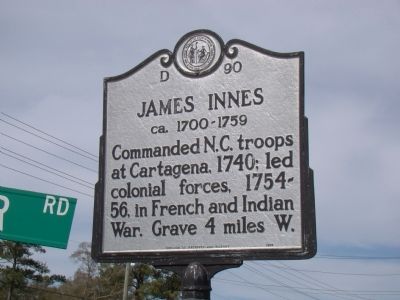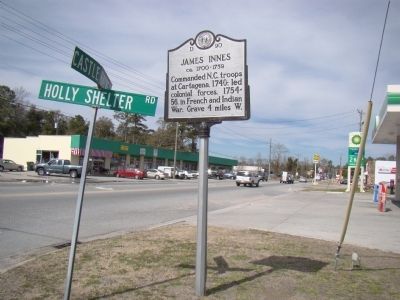Castle Hayne in New Hanover County, North Carolina — The American South (South Atlantic)
James Innes
ca. 1700–1759
Erected 1989 by Division of Archives and History. (Marker Number D-90.)
Topics and series. This historical marker is listed in these topic lists: Colonial Era • War, French and Indian. In addition, it is included in the North Carolina Division of Archives and History series list. A significant historical year for this entry is 1740.
Location. 34° 21.276′ N, 77° 53.994′ W. Marker is in Castle Hayne, North Carolina, in New Hanover County. Marker is at the intersection of Castle Hayne Road (U.S. 117) and Holly Shelter Road, on the right when traveling north on Castle Hayne Road. Touch for map. Marker is in this post office area: Castle Hayne NC 28429, United States of America. Touch for directions.
Other nearby markers. At least 8 other markers are within 8 miles of this marker, measured as the crow flies. Early Drawbridge (approx. half a mile away); Prisoner Exchange (approx. ¾ mile away); Alexander Lillington (approx. 6.1 miles away); Maurice Moore (approx. 6.1 miles away); James Moore (approx. 6.1 miles away); General John Ashe (approx. 6.6 miles away); George Davis (approx. 7.3 miles away); David Walker (approx. 7.9 miles away). Touch for a list and map of all markers in Castle Hayne.
Additional commentary.
1. James Innes
Entry in the 1905 book Biographical History of North Carolina edited by Samuel A. Ashe et al. The appointment of Gabriel Johnston to be governor of North Carolina in 1733 apparently led to quite an influx of Scotchmen to the Cape Fear, which was then rapidly coming into note as a favorable location in the New World. Among those who were attracted to the little hamlet of Newton at that time was Captain James Innes, who probably had resided at Cannisbay, in Caithness, in the extreme northern part of Scotland, near “John O’Groat’s house.” Within a month after the arrival of Governor Johnston he issued commissions to justices to hold precinct courts, and among the justices for New Hanover Precinct was named James Innes, and in May, 1735, the governor recommended Innes for a place in his Majesty’s Council, and appointed him assistant to William Smith, chief baron of the province. Captain Innes speedily became a resident of Wilmington, and was a warm friend of the governor in his various controversies with the older settlers.
It appears that he had seen service in the British army, and when, in the fall of 1740, four companies of troops were raised in North Carolina for service against the Spaniards, Captain Innes was appointed to command the company raised on the Cape Fear. This battalion took an active part in the sea attack upon Boca Chico, and subsequently aided in the deadly assault upon Fort San Lazaro at Cartagena. In that disastrous campaign Captain Innes was intimately associated with Lawrence Washington, the elder brother of General George Washington, and other colonial officers, and he himself won great reputation for capacity, judgment and cool conduct. This expedition ended disastrously, particularly because the troops were swept away by a malignant fever, so that probably of the 400 North Carolinians who were engaged on it, not onefifth survived.
Returning to North Carolina, Captain Innes became a successful planter, was colonel of the militia in New Hanover County, and one of Granville’s agents for the sale of his land. In 1750, on the death of Eleazer Allen, he became a member of the Council, and was justly esteemed as one of the first men of the province. When the French and Indian War broke out, in 1754, the North Carolina Assembly promptly provided for raising a regiment to assist in the defense of Virginia, and Colonel Innes was appointed colonel of that force. Governor Dinwiddie, who seems to have known Colonel Innes well, addressing him as “Dear James,” and conveying in his letters messages from his wife and daughters, tendered him the position of commander-in-chief of all the forces raised for defense. Colonel Innes modestly demurred, but Governor Dinwiddie replied: “Your age is nothing when you reflect on your regular method of living; and as for the expectations of the people here, I always have regard to merit, and I know yours, and you need not mind or fear any reflections.”
Colonel Fry had been the commander-in-chief and Lieutenant-colonel George Washington was under him, but Colonel Fry died, and Washington might have expected to succeed him. However, on being informed by Governor Dinwiddie of the appointment of Innes, Washington wrote: “I rejoice that I am likely to be happy under the command of an experienced officer and man of sense. It is what I have ardently wished for.” About the last of June, 1754, the North Carolina regiment, which had been reduced to 450 rank and file, began to arrive at Winchester, where they found that no provisions had been collected for them and no ammunition supplied, and their pay was in arrears; and, moreover, the governor suggested to Colonel Innes to build a log fort and magazine, saying that he did not wish the force to proceed toward the Ohio, and informed him, “I can give no orders for entertaining your regiment, as this Dominion will maintain none but their own forces.” Indeed, Colonel Innes discovered a strong feeling among the Virginians against his appointment to the chief command, and a mutinous disposition soon developed itself among them. The unfavorable situation led Colonel Innes to disband his North Carolina regiment and order their return to North Carolina.
He himself was directed to build a fort on Wills Creek, afterward called Fort Cumberland, and not being allowed to go to the front, he remained there in command of about 400 men, only forty of whom were North Carolinians. Early in October Governor Sharpe of Maryland produced a commission from the King appointing him commander-in-chief, and Innes wished to resign and retire, but was prevailed on to retain his rank and accept the appointment of camp master general; and he remained on the frontier organizing the forces and completing the fort. Governor Sharpe did nothing, and the next year General Braddock arrived from England with a large force of British regulars. When Colonel Washington found that the orders gave precedence to British officers of the same grade over colonial officers of senior commissions, he threw up his commission and retired from the service, but was prevailed on to serve as an aide on Braddock’s staff. Braddock appointed Innes governor of Fort Cumberland, and left him in command there when the forces advanced toward Fort Duquesne. When disaster overtook that brave but reckless general, and his routed forces returned as fugitives to Fort Cumberland, Colonel Dunbar, then in command, precipitately continued his frenzied flight and hurried in August to find winter quarters in Philadelphia.
The flight of the regulars disorganized the provincials, and many of Captain Brice Dobbs’s North Carolina company deserted; still, there were some forty or fifty North Carolinians at the fort remaining with Colonel Innes. Colonel Dunbar left there some three or four hundred sick and wounded to be cared for. Colonel Innes had urged him to send a reconnoitring party to Great Meadows, but Colonel Dunbar could not wait. Colonel Innes therefore despatched such a party from his weak garrison.
On the 25th of August Governor Dinwiddie wrote Colonel Innes as follows:
“Yours of the 17th of August I received by Jenkins, and copy of both yours to Colonel Dunbar. His answer to your first is very evasive. Your last to him was extremely proper and personal. ... I shall very soon augment our forces to 1200 men, and then order as many as you think proper for your assistance. ... I am, Dear James, yours affectionately.”
Governor Dinwiddie appointed Washington to the command of the new levies, and a month later Colonel Innes returned to North Carolina on leave of absence. But on the 10th of October Governor Dinwiddie advised Governor Dobbs that the French and Indians had surrounded Fort Cumberland, had killed and scalped nearly one hundred of the people and had cut off the communication between the fort and the inhabitants. “I wish for Colonel Innes’s return.” Without a day’s delay Colonel Innes hurried again to Fort Cumberland and remained there until the following summer, when, new dispositions being made and the immediate frontier being quiet, he returned to North Carolina, and eventually retired from the service. As a competent, vigilant and efficient officer, faithfully discharging trying duties, he lost no reputation amid all the difficulties of the unfavorable circumstances by which he was surrounded. He died at his home near Wilmington on September 5, 1759.
In his will Colonel Innes gave his plantation, Point Pleasant, a considerable personal estate, his library and £100 sterling “for the use of a free school for the benefit of the youth of North Carolina,” this being the first private bequest for educational purposes in the history of our people. He also made provision for the purchase of a church bell for the parish church at Cannisbay, in Caithnesse, and directed that £100 should be put at interest for the poor of that parish.
In 1761 Colonel Innes’s widow, Jane, married Francis Corbin, who had come in 1744 to North Carolina as the agent of Lord Granville. —S. A. Ashe.
— Submitted March 20, 2010.
Additional keywords. Colonel James Innes
Credits. This page was last revised on June 30, 2021. It was originally submitted on March 20, 2010, by J. J. Prats of Powell, Ohio. This page has been viewed 2,239 times since then and 18 times this year. Photos: 1, 2. submitted on March 20, 2010, by J. J. Prats of Powell, Ohio.
Editor’s want-list for this marker. Photo of gravesite. • Can you help?

